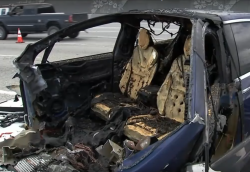
— A deadly Tesla Model X crash in 2018 around the area of US-101 and State Route 85 in California was caused by the driver, Tesla's Autopilot system, inaction by the National Highway Traffic Safety Administration and inaction by officials in California.
The Model X crash killed 38-year-old Walter Huang who was playing a video game on his phone when the SUV slammed head-on into a damaged crash attenuator installed to decrease crash forces.
In a report from the National Transportation Safety Board (NTSB), Huang was partially blamed for the 70 mph crash for not paying attention to his surroundings, the road and the Model X.
Huang had even previously complained about his Model X steering toward the same attenuator when Autopilot was engaged, yet he still allowed it to happen while he focused on his phone.
The NTSB says Autopilot was engaged with Traffic-Aware Cruise Control set at 75 mph when the lane-keeping assist system Autosteer initiated a left steering input while the SUV was about 5.9 seconds and 560 feet from the crash attenuator.
Autopilot and other safety systems apparently took a vacation because the forward collision warning system did not provide an alert and automatic emergency braking did not activate. Mr. Huang also did nothing to avoid the crash, not by steering, braking or any other action.
Mr. Huang may not have taken any actions to avoid the crash, but there is still the issue of why the Model X failed to follow the correct lane in the first place.
NTSB investigators believe various causes were responsible. These include bright sunlight that interfered with the cameras on the SUV, road lane lines that were faded and because of how close the vehicle ahead was to the Tesla Model X.
In its final report, the NTSB found the probable cause of the crash as Tesla's Autopilot system which steered the Model X into the barrier. Also listed are the driver's complete lack of response due to distraction from a game on his cell phone, and his overreliance on Autopilot.
The report says the crash attenuator barrier had been damaged in a separate crash more than a week before the Model X crash, and the damaged barrier contributed to the driver's injuries.
The California Highway Patrol was also blamed for failing to report the previous attenuator damage, and the maintenance department of the California Department of Transportation was named for not repairing the barrier in a timely manner.
In addition to blaming NHTSA, which has done nothing to prevent distracted driving, the NTSB said tech companies should do more to create phones and devices that cannot be used while driving unless in emergencies.
NHTSA has also allowed automakers to install every kind of distracting infotainment system imaginable while automakers boast about the safety of the systems, even though the devices are incredibly distracting.
The NTSB also says Tesla is failing consumers by placing vehicles on the roads with technology in "beta" mode, which means the systems are being tested on public roads and then updated when defects or bugs are discovered.
According to the NTSB, it should be obvious that crashes and injuries will likely occur, then Tesla will deny all responsibility by telling the public they were warned the systems were still being tested.
Government officials emphasize there is no vehicle that can drive itself, a fact that seems to be lost on many Tesla drivers.
Safety advocates have been screaming for years about NHTSA allowing automakers to self-regulate their self-driving cars and technology, primarily by creating voluntary guidelines that are contributing to crashes and deaths.
The Center for Auto Safety (CAS) says the story may be about Tesla and the NTSB, but the real story is the lack of leadership at the National Highway Traffic Safety Administration. According to the Center, NHTSA's "willing ignorance or extraordinary incompetence" is causing the agency to "fade ever more into irrelevance."
The NTSB crash report blames NHTSA and the U.S. Department of Transporation (DOT) for ignoring multiple previous safety recommendations and taking a "nonregulatory approach to automated vehicle safety."
The report says NHTSA has failed to protect consumers by failing to ensure automakers install safeguards for systems related to automation.
"The National Highway Traffic Safety Administration’s approach to the oversight of automated vehicles is misguided, because it essentially relies on waiting for problems to occur rather than addressing safety issues proactively." - NTSB report
According to the NTSB, partial automation doesn't mean "self-driving," and a driver cannot read a book, watch a movie, read a cell phone or play a video game without risking their own and everyone's property and life.
The driver's family filed a lawsuit against Tesla by claiming Mr. Huang believed the technology was safe.




